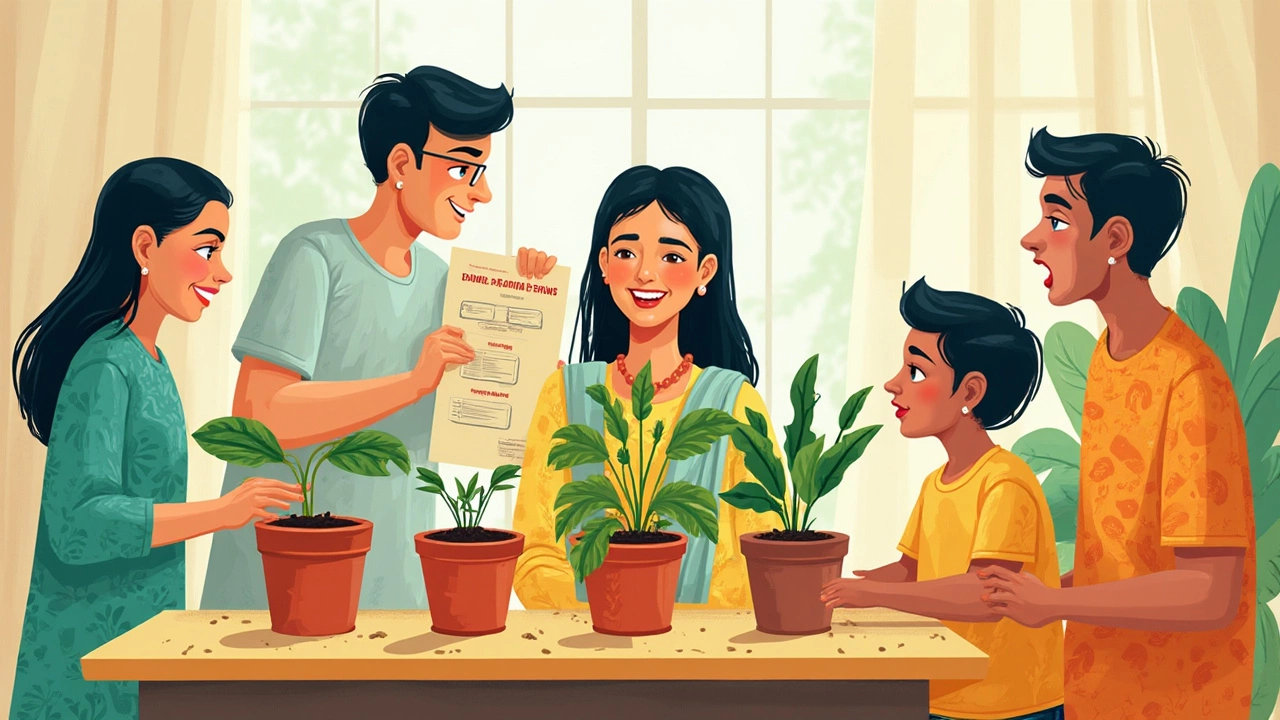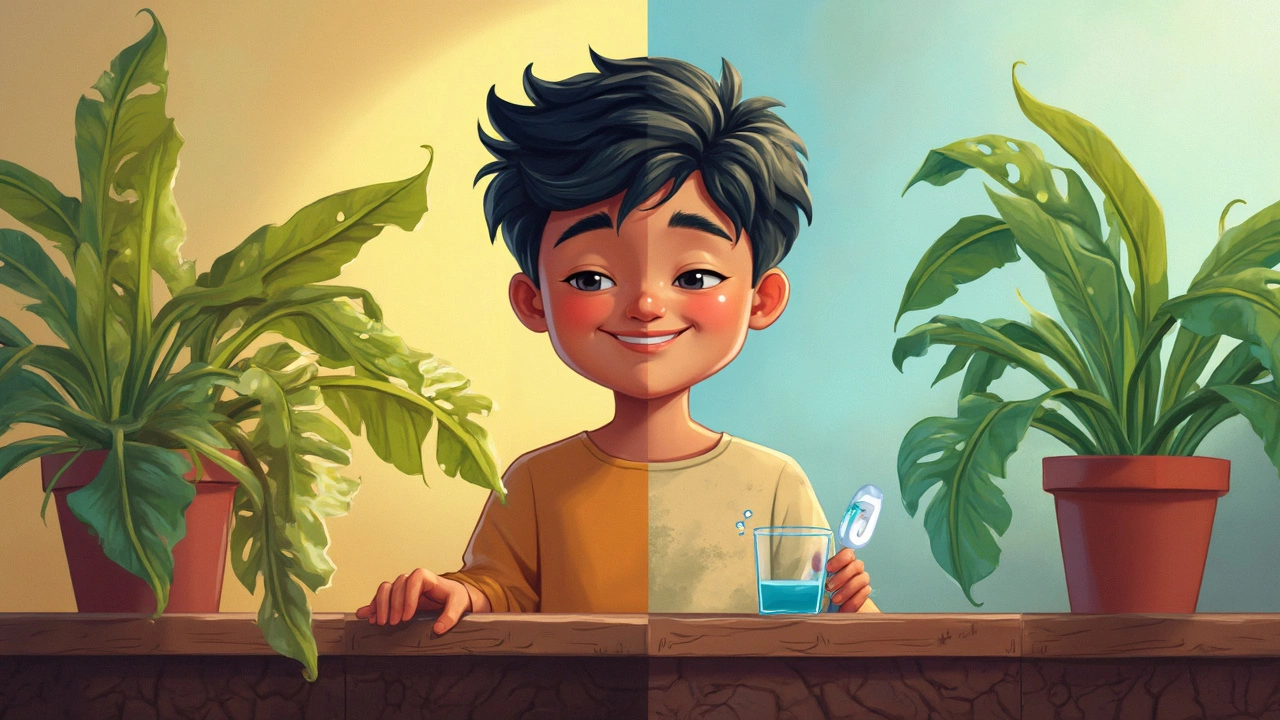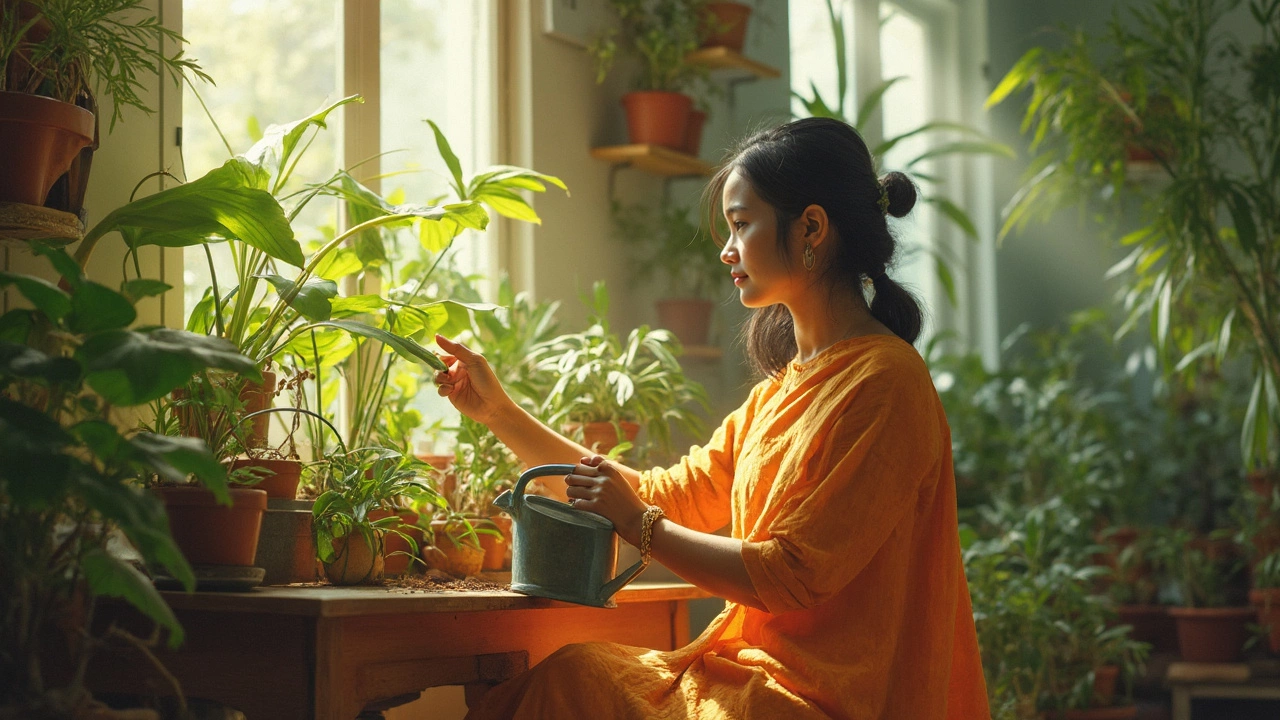Ever walk by your plant and wonder, “Should I water you today or wait?” You’re not alone. There isn’t one magical answer, because what works for a cactus in Phoenix can drown a fern in Boston. Plants just don’t run on a ‘once-a-week’ calendar.
Here’s the thing: watering isn’t about guessing or blindly following internet charts. It’s about reading your plant’s signals, checking the soil, and knowing a few basic rules. If you usually stick to one schedule for all your plants, you’re probably watering too much or too little—sometimes both, just not for the same plant.
Some folks get hung up on apps and reminders, but honestly, your finger works better than any digital tracker. Poke the soil. Is it dry a couple inches down, or still damp? That quick check can save your plant from both crispy leaves and soggy roots. If you’re ready to ditch the one-size-fits-all approach, you’ll see your houseplants perk up in no time.
- Why Set Schedules Usually Fail
- Knowing Your Plant's Water Needs
- How to Check If It's Time to Water
- Factors That Change Watering Frequency
- Watering Mistakes (and How to Avoid Them)
Why Set Schedules Usually Fail
People like order, but houseplants just don’t care about your calendar. Sticking to a strict watering day—say, every Sunday—creates more problems than it solves. There’s a good reason a peperomia and a fern shouldn’t be watered the same way each week: they live totally different lives, even sitting a few feet apart on your shelf.
The biggest issue? Watering indoor plants depends on what’s actually going on in the pot, not on the date. Look at this table. It shows how much things can change:
| Factor | Why it Matters | Example |
|---|---|---|
| Season | Plants drink more in summer, less in winter | Snake plant needs weekly watering in July but once a month in January |
| Light | More sunlight equals thirstier plants | Windowsill pothos dries out twice as fast as a plant in the hallway |
| Pot Size & Material | Tiny pots and clay pots lose water quicker | Six-inch terracotta dries fast, ten-inch plastic stays wet longer |
| Humidity & Temperature | Hot/dry air means more frequent watering | Radiator nearby dries soil in days, cool rooms keep soil moist |
If you just set a reminder and ignore what your plant actually needs, you might see yellow leaves (from overwatering) or crispy brown tips (from not enough). The truth? Even on the same shelf, two plants might need water at totally different times. One week, you may barely touch your pothos, the next week you could be reaching for your watering can more often thanks to a heatwave or open window.
If you want happier plants, toss the outdated “once a week” rule and start paying attention to what’s really happening in the pot. Your houseplants—and your sanity—will thank you for it.
Knowing Your Plant's Water Needs
The number one reason houseplants struggle? We water all of them the same way, like they’re clones. But each plant has its own style. Think about it: some plants come from rainforests, some from deserts. It’s no surprise they expect different treatment at home.
Here’s where you start—learn what your specific plant likes. Plants like snake plants, succulents, and cacti want their soil bone-dry before you give them another drink. On the flip side, ferns, peace lilies, and calatheas like things a bit more moist. If you see “tropical” on a tag, expect it to want steady humidity and regular watering.
Your plant's size matters, too. A small pot dries out way faster than a big one. Tiny roots just can’t hold much water. And if you’ve got a new plant, don’t trust the nursery’s routine—those setups are built for sales, not home-life.
If you’re not sure what plant you’ve got, snap a pic and use a plant ID app. Most houseplants fall into a couple of main types:
- Succulents and cacti: Water when soil is totally dry. Go easy in winter—they need even less then.
- Tropical plants (like monstera, philodendron, pothos): Water when the top inch or two of soil feels dry.
- Ferns and calatheas: Keep soil slightly damp, but never soggy.
Reading up on your plant’s background is the best way to nail how often to water. And if you forget, here’s one reliable trick: it’s safer to underwater than overwater most plants. Roots hate being waterlogged. You’d be shocked how many “dead” plants could have lived if folks just held back the watering can.

How to Check If It's Time to Water
Forget sticking to a strict calendar—your plant doesn’t care what day it is. The real trick is figuring out what’s going on in that pot. The easiest, most reliable way is simply the finger test. Stick your finger about two inches into the soil (up to your first knuckle). If it feels dry down there, it’s probably time to water. If it’s still a little damp, leave it be and check again in a couple of days.
- For cacti and succulents, let the soil get bone dry before watering—these guys like it rough.
- For leafy tropical plants like pothos or peace lilies, water when the top inch or so feels dry. Their roots need some moisture but don’t want to sit in soggy dirt.
- Plants with thin or papery leaves, like ferns, often prefer evenly moist soil—don’t let them fully dry out.
Use the pot’s weight as a sneaky trick. Pick up your plant soon after you water it—get a feel for ‘heavy’ wet soil. A few days later, try again. If the pot feels super light, water is probably overdue. This is quicker than it sounds, especially with smaller pots.
Root rot happens fast if you overwater, so never trust just the surface. Soil can dry out up top but still be soaked underneath. That’s how lots of folks end up with yellow, mushy leaves.
If you want to get a tiny bit geeky, soil moisture meters are cheap and can help you read what’s happening below where your finger can reach. They’re not perfect, but they’ll let you double check your instincts—useful if you're still figuring out the routine.
| Sign | Dry Soil | Moist Soil |
|---|---|---|
| Color | Lighter, pale brown | Darker, rich brown |
| Feel | Crumbly, dusty | Cool, a little sticky |
| Weight | Noticeably lighter | Feels heavier |
Here’s the bottom line: pay attention to what watering indoor plants actually looks like, and don’t just water out of habit. Adapt your checks based on the plant and its pot. It’ll save you more dying leaves than anything else you can buy.
Factors That Change Watering Frequency
Before you reach for the watering can, take a second to look around—and think about what’s actually happening in your space. How often you water houseplants comes down to a mix of different things, way beyond just the type of plant.
Here are the main reasons your plants might need more or less water than you’d expect:
- Light: Plants soaking up lots of sunlight dry out faster. That snake plant basking on the windowsill will likely be thirsty twice as often as the one in your office corner.
- Temperature: Warm rooms speed up evaporation. During summer or in a cozy heated room, soil loses moisture faster—expect to water more often.
- Humidity: Dry indoor air makes water disappear from the soil quicker. This gets tricky in winter, especially if you’re running a heater.
- Pot Size: Big pots hold more soil and water, so they dry out slower. Tiny pots? They turn bone dry in no time.
- Soil Type: Some mixes hold water like a sponge, while gritty, sandy soils let water drain right through. If your plant’s soil has lots of perlite or sand, expect to check it more often.
- Plant Growth Stage: Baby plants and freshly repotted ones are thirstier while they’re growing roots, but once they get settled, their water needs often drop.
Here’s a quick look at how these factors can impact your watering schedule:
| Factor | Effect on Watering |
|---|---|
| Bright Light | Needs water more often |
| Low Humidity | Dries soil faster |
| Warm Room | Soil dries quicker |
| Large Pot | Keeps water longer |
| Well-draining Soil | Loses moisture fast |
Don’t forget, plants actually need less water in winter because most go into a chill-out mode and stop growing much. On the flip side, if you crank up the heat indoors or face a super dry spell, you might have to water a bit more. Always check the soil before you water. That single move will save you more plants than any fancy system.
One last tip: keep an eye out when you move a plant or change where it lives. Biggest watering mistakes usually happen right after moving the plant to a new spot with different light or air flow. Stick your finger in the dirt, and adjust from there. It’s really that simple.

Watering Mistakes (and How to Avoid Them)
If you think the biggest threat to your houseplants is forgetting to water, think again. Statistically, more houseplants die from overwatering than underwatering. In fact, a 2023 survey of home gardeners showed that 62% blamed root rot or constant soggy soil for dead indoor plants. So, if you’ve been generous with the watering can, you’re not alone.
Let’s break down what goes wrong and how to dodge the usual headaches:
- Overwatering: This is the classic mistake. When you water too often, plant roots sit in wet soil for too long. That blocks oxygen, and fungi can take over. Leaves might droop, turn yellow, or drop off. The soil will probably smell musty.
- Underwatering: It doesn’t get as much attention, but skipping water can stress plants out. Leaves go brown and crispy, and the soil pulls away from the pot edges.
- Bad Drainage: Even perfect watering habits won’t save a plant stuck in a pot without drainage holes. Water backs up, and roots rot no matter how careful you are.
- Ignoring Plant Type: A snake plant likes things dry, but a peace lily will wilt if you slack off. Using the same routine for all your plants never works.
- Watering the Leaves: Splashing water on leaves can lead to spots and fungus. Always aim for the soil.
Some easy fixes help avoid these traps:
- Use pots with drainage holes. It’s the best insurance against soggy soil.
- Pick up the pot. If it feels surprisingly light, it’s probably thirsty.
- Poke a finger in the dirt every time—not just when the calendar says so.
- Group plants with similar water needs. It’ll make your life easier.
- When in doubt, less is more. Most houseplants can bounce back from dryness faster than from drowning.
Check out this quick guide to common watering slip-ups and what you can watch out for:
| Watering Mistake | Sign You’ll See | How to Fix It |
|---|---|---|
| Too Frequent Watering | Yellow leaves, mushy stems, musty smell | Water only when top 1-2 inches of soil are dry |
| Underwatering | Dry, brittle leaves, leaf drop, slow growth | Set a reminder to check soil and water when dry |
| No Drainage | Wilting despite wet soil, root rot, fungus gnats | Repot in a container with holes or use a nursery pot |
| Wrong Watering Technique | Spots on leaves, mold growth | Water at the base, not on the leaves |
There’s no secret formula, but if you focus on the needs of each plant and get to know what dry soil really feels like, watering will get a lot less stressful. Save the guesswork—let your plant and its dirt tell you what it needs. Trust your real-life checks more than any rule you read online about how often to water houseplants.

